Schwinn Meridian Adult Tricycle User Manual | Assembly Instructions
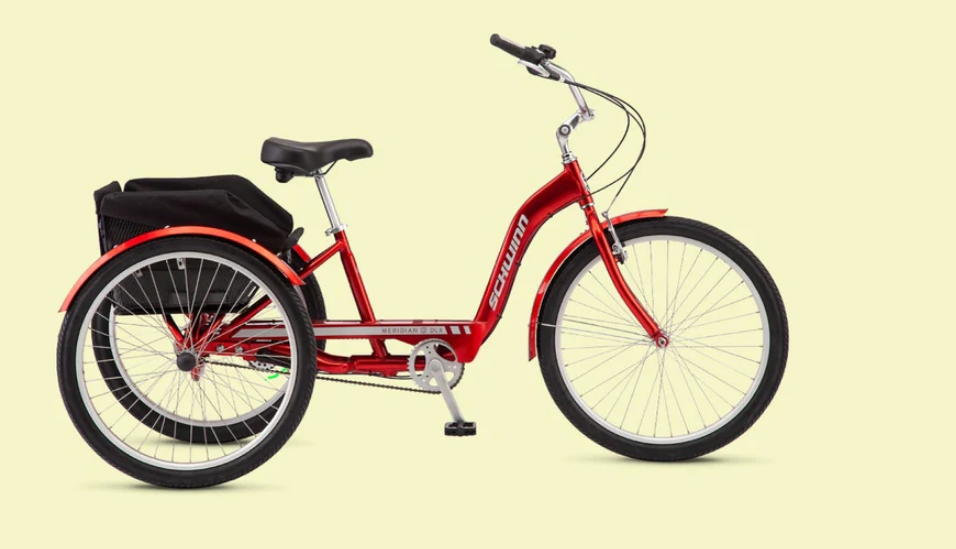
Content
Schwinn Meridian Adult Tricycle Introduction
The Schwinn Meridian Adult Tricycle is a versatile and comfortable ride designed for adults seeking stability, convenience, and safety. With features like adjustable height suitability, a dual braking system, a foldable cargo basket, and a stylish design, this tricycle promises a delightful and worry-free riding experience. It accommodates riders ranging from 5'4" to 6'2" in height and has a recommended weight limit of 300 pounds. The cost of the Schwinn Meridian Adult Tricycle is approximately $399.99.
Detailed Specifications
- Frame: Sturdy steel frame with a low-step design for easy mounting and dismounting.
- Wheels: 26-inch alloy wheels with wide, durable tires for stability and comfort.
- Brakes: Reliable alloy linear-pull brakes for safe stopping.
- Seat: Comfortable, padded seat with a backrest for added support.
- Basket: Large, foldable basket perfect for carrying groceries or other items.
- Gears: Single-speed or 3-speed drivetrain options available.
- Weight Capacity: Supports riders up to 250 lbs.
Parts
Before assembly check and see that all the parts are included

Hardware
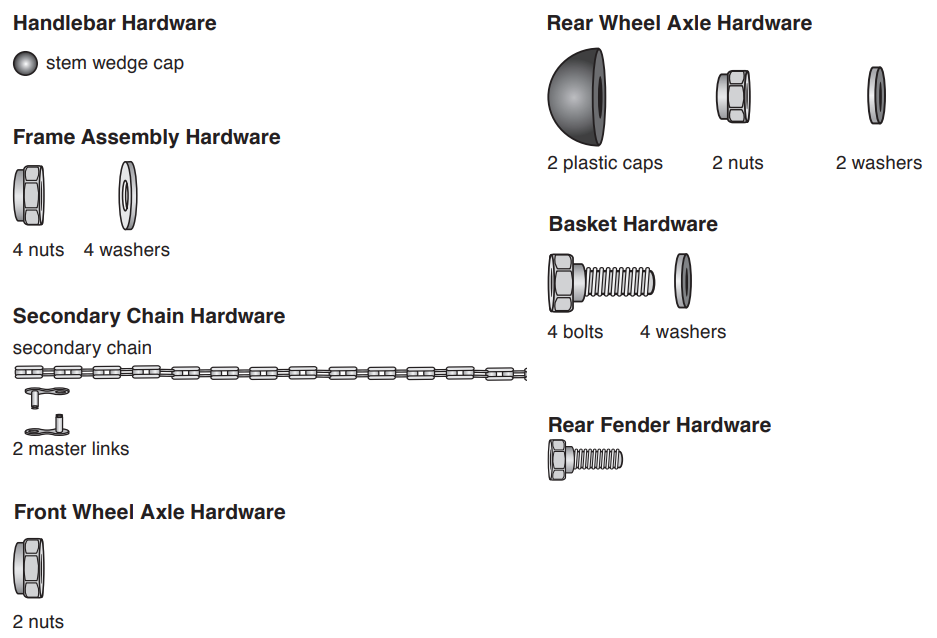
Description
The Schwinn Meridian Adult Tricycle is built to provide a comfortable and stable riding experience. The low-step frame allows riders to easily step on and off the tricycle, reducing strain on the knees and making it accessible for a wide range of users. The padded seat and backrest ensure long rides remain comfortable, while the large basket offers ample space for carrying essentials. With its durable construction and reliable braking system, this tricycle is perfect for daily use.
Assembly
WARNING! Improperly assembly of the tricycle may result in unexpected product performance and serious injury or death. Assemble the tricycle according to the instructions in this manual or have a professional bicycle mechanic assemble the tricycle.
Getting Organized
(Two-Person Assembly Required)
The following tools and items are needed for assembly:
- Phillips head screw driver (minimum four inch shaft)
- 5 mm, 6 mm Allen keys
- Adjustable wrench or 10 mm, 15 mm, and 17 mm open and box end wrenches
- Needle nose pliers with cable cutting ability
- Grease (Automotive or anti-slip copper grease)
Initial Set-up
Attach the Handlebars
Parts: Handlebar, main frame
Hardware: The stem wedge bolt and binder bolt come attached to the handlebar. Stem wedge bolt cap.
Tools: 6 mm allen wrench, grease
- Position fork so the front brake is facing the front of the bike. Make sure the brake cables are not tangled or twisted. Refer to photo on Page 10.
- Remove the cap covering the stem wedge bolt.
- Apply a light layer of grease to the stem and frame head tube.
- Insert the stem of the handlebar into the frame head tube until the Minimum Insertion mark is not visible. If necessary, unscrew the stem wedge bolt until there is play in the stem wedge.
NOTICE
The stem may break or damage may occur if the stem is not inserted the minimum amount. Insert the stem until the Minimum Insertion mark is not visible. - Rotate the handle bar so it is square with the fork.
- Tighten the stem wedge bolt to lock the stem in place.
- Replace the cap onto the stem wedge bolt.
- Loosen the handlebar binder bolt and rotate the handlebar into the riding position.
- Using the 6 mm allen wrench, tighten the handlebar binder bolt until the handlebar is locked in place.
- Turn the tricycle assembly over so it rests on the handlebar and main frame.
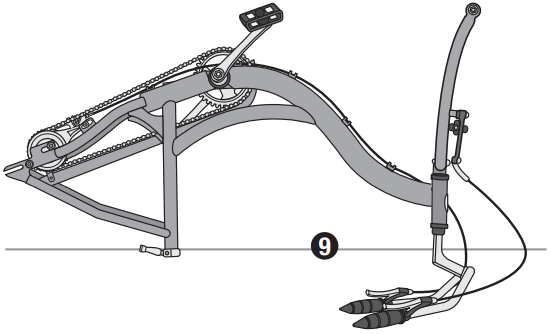
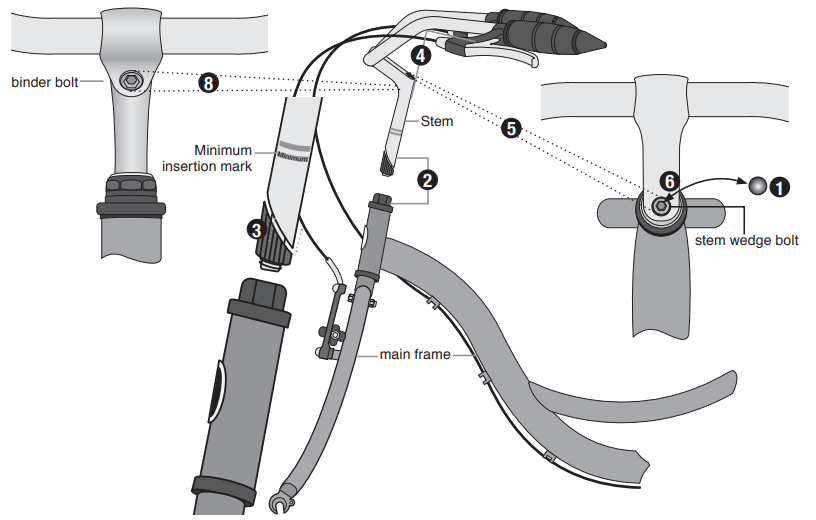
Attach the Rear Frame
Parts: rear frame, main frame
Hardware: 4 nuts, 4 square bolts, 4 washers, come attached to the frame. Remove the nuts and washers only.
Tools: None required.
- Attach the rear frame to the main frame of the tricycle. Slide the U-shaped slot at the end of the rear frame onto the bolts next to the chain on the main frame. At the same time align the L-shaped slots of the rear frame with the bolts at the rear of the main frame.
- Slide a washer over the end of a bolt and fasten a nut to the end of the bolt. Note: Do not tighten the nuts at this time. This will be done after the secondary chain is attached.
- Repeat step 2 on the remaining bolts.
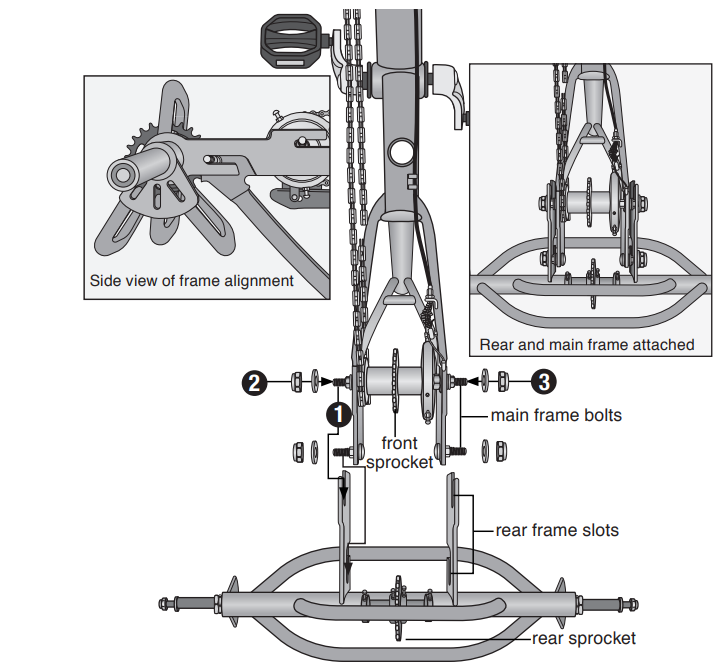
Attach the Secondary Chain
Parts: secondary chain, frame assembly
Hardware: 2 master links
Tools: 17 mm open and box end wrench.
- Wrap the secondary chain around the front sprocket on the rear hub and rear sprocket on the rear axle.
- Adjust the position of the rear frame until the ends of the secondary chain meet each other, leaving one chain link length space in between the ends.
- To connect the two ends of the chain:
- Insert the post of a master link through the hole on the end of the secondary chain link.
- Insert the post of the other master link through the opposite end of the secondary chain, and on the opposite side of the chain.
- Pull the chain so the posts are inserted into the smaller hole of the master chain.
- Pull the rear frame back so the secondary chain is taut and there is less than 5 mm of play up or down.
Important! Be sure the rear frame is perpendicular to main frame. Failure to square the frames will affect performance of the tricycle. - Firmly tighten the four bolts holding the rear frame to the main frame. Tighten nuts to 240in-lbs.
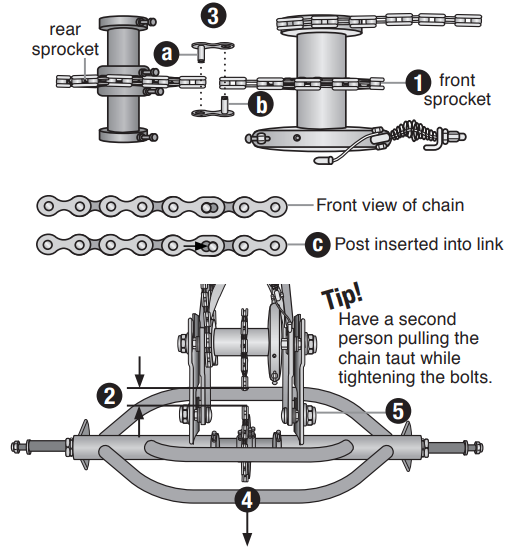
Attach the Rear Wheels
WARNING! Failure to properly tighten the nuts holding the wheels onto the tricycle may result in poor riding performance, the tire falling off and serious injury or death. Always be sure the wheels are securely attached to the frame before using the tricycle.
Parts: Drive wheel, non-drive wheel
Hardware: 2 plastic caps, 2 locknuts, 2 washers.
The locknuts come attached to the axle. Remove the locknuts before you begin this procedure.
Tools: 17 mm open and box end wrench
See the facing page for diagrams of the following steps.
- Place the drive wheel (with a half-moon opening) on the axle.
- Place the washer on the axle.
- Place the locknut on the axle and tighten securely.
Screw the plastic caps on each end of the axles.
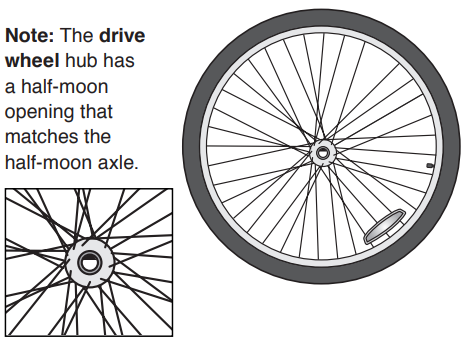
Note: The drive wheel hub has a half-moon opening that matches the half-moon axle.
- To attach the non-drive wheel repeat steps 1-4.

Note: To prevent the axle from turning while attaching the non-drive wheel, it is important to hold the drive wheel while tightening the locknut on the non-drive wheel.
Attach the Front Fender
Parts: Front fender, main frame
Hardware: washer, long screw, small screw,
Tools: Phillips head screwdriver or 10mm hex wrench
See the facing page for diagrams of the following steps.
- Remove the fork protector (not shown).
- Lift the brake noodle and cable out of the brake carrier.
- Remove the fender hardware from the fork (bolt, washer).
Position the front fender so the attachment bar is on the inside of the main frame, and aligns with the threaded screw hole of the fork.

- Place a washer on the large screw and slide it through the fender attachment bar, and into the threaded hole in the fork.
- Align the fender braces with the small hole on the ends of the fork.
Loosely screw the fender braces to the fork.
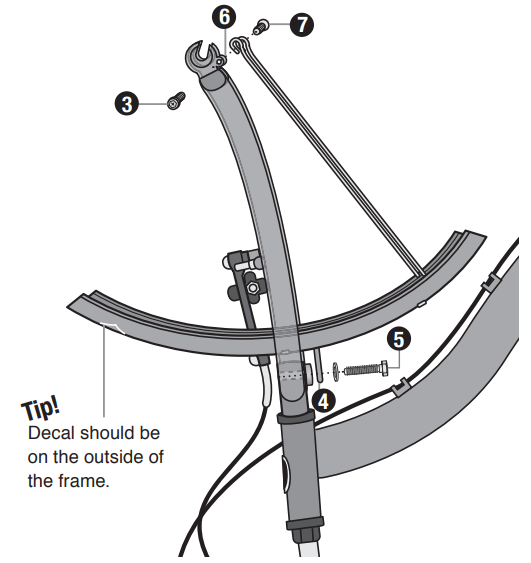
Note: The fender will be positioned and firmly fastened after the front tire is attached.
Attach the Front Wheel
WARNING!
Failure to properly tighten the nuts holding the wheels onto the tricycle may result in poor riding performance, the tire falling off and serious injury or death. Be sure the wheels are securely attached to the frame before using the tricycle.
Parts: Front wheel, main frame assembly
Hardware: 2 large nuts, 2 washers
Tools: 15 mm open and box end wrench, Adjustable Pliers
- Loosen nuts on the front wheel axle.
- Place the front wheel axle in the fork drop-outs, making sure the wheel is centered.
- Tighten nuts to 240in-lbs.
- Tighten fender hardware, making sure the tire does not rub on the fender.
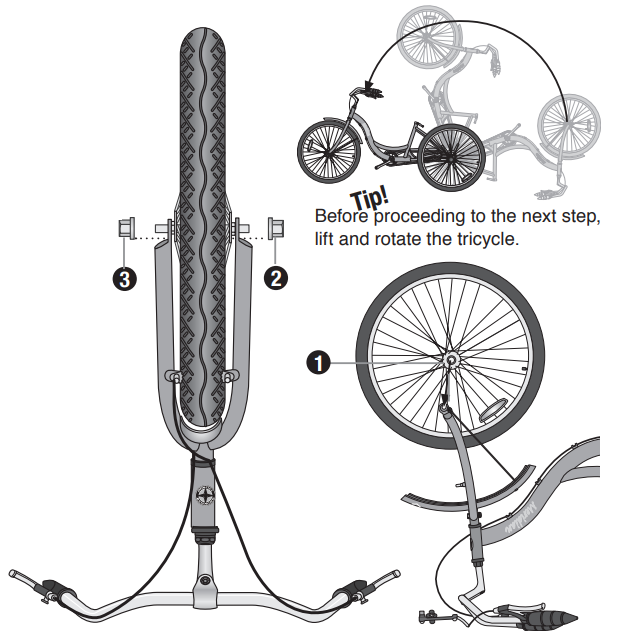
Assemble the Front Brake
WARNING!
Failure to properly set the brakes may result in the inability to stop the tricycle movement and cause serious injury or death. Be sure the brakes are functioning properly before using the tricycle.
Note: The tricycle is shipped with the brake cable attached to the brake lever. Follow these steps if there is a need to re-attach the brake cable to the brake lever:
- Rotate the cable adjustment barrel and cable nut until the slots are aligned with the slot on the brake lever body.
- Press the brake lever towards the grip.
- Slide the brake cable through the slots and place the cable head into the brake lever.
- Release the brake lever.
- Lightly pull on the cable, and rotate the cable nut and cable barrel so they are no longer aligned.
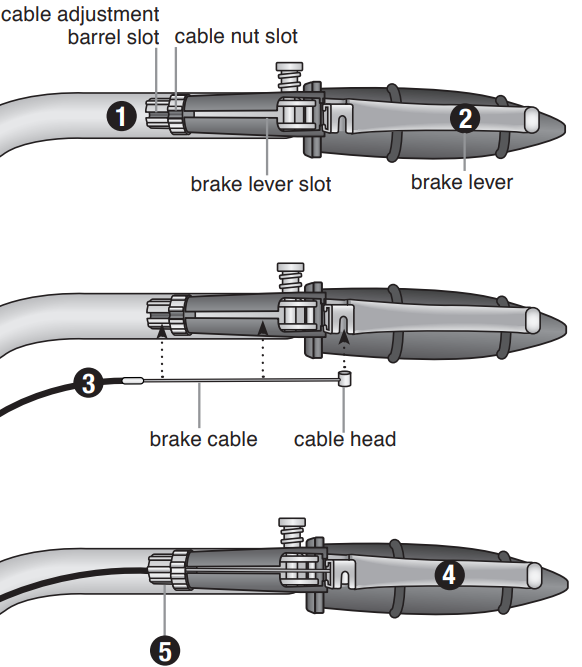
Attach the Brake Noodle to the Brake Carrier
- Squeeze the two brake arms together until the brake pads touch the wheel rim.
- With your opposite hand, pull the brake cable and insert the end of the brake noodle into the brake carrier.

Schwinn Meridian Adult Tricycle Maintenance
WARNING!
Failure to conduct maintenance on the tricycle may result in malfunction of a critical part and serious injury or death. Proper maintenance is critical to the performance and safe operation of the tricycle. The recommended intervals and need for lubrication and maintenance may vary depending on conditions the tricycle is exposed to. Always inspect the tricycle and conduct necessary maintenance before each use of the tricycle.
This section presents important information on maintenance and will assist you in determining the proper course of action to take if you do have a problem with the operation of the tricycle.
If you have questions regarding maintenance please call our customer service, toll free, at 1-800-626-2811 or see a qualified bicycle mechanic. Do not call the store where the tricycle was purchased.
Lubrication Schedule
Component | Lubricant | Method |
Weekly | ||
| Chains | Chain lube or light oil | Brush on or squirt |
| Brake calipers | Oil | Three drops from oil can |
| Brake levers | Oil | Two drops from oil can |
Every Six Months | ||
| Freewheel | Oil | Two drops from oil can |
| Brake cables | Lithium based grease | Remove cablefrom casing . Grease entirelength . Wipe off excess lubrication from other surfaces . |
Brake leverand caliper pivot points | Light oil | Two to threedrops from oilcan |
| Pedals: that cannotbe disassembled | Light oil | Two drops from oil can onto the inside bearings |
Yearly | ||
| Bottom bracket | Lithium based grease | Disassemble |
| Pedals | Lithium based grease | Disassemble |
| Wheel bearings | Lithium based grease | Disassemble |
| Headset | Lithium based grease | Disassemble |
| Seat stem | Lithium based grease | Disassemble |
| Pedals: that can be disassembled |
| See bicycle mechanic for maintenance . |
NOTE: The frequency of maintenance should increase with use in wet or dusty conditions. Do not over lubricate. Remove excess lubricant to prevent dirt build up. Never use a de-greaser to lubricate your chains (WD-40®).
Parts Maintenance
Wheels
Frequency: Inspect and maintain before each use.
Inspect | Action | Maintenance |
| Rims | Inspect for dirt and grease | Use a clean rag or washwith soapy water, rinse, and air dry . |
| Wheels | Check the wheels aresecurely fastened to the tricycle and axle nuts are tight . | Adjust if necessary and tighten axle nuts . |
Spin wheeland check thatrotation and alignment are true | See bicycle mechanic for repair . | |
| Spokes | Check for broken or loose spokes | See bicycle mechanic for repair . |
| Hub Bearings | Lift eachwheel and seeif there is movement side to side | See “HubBearings” for more detail or bicycle mechanic for repair . |
Tires
Frequency: Inspect and maintain before each use
Inspect | Action | Maintenance |
| Tire Inflation | Check tire pressure | Inflate tire to the pressure indicated on the tire sidewall. See “Inflating a Tire Tube” for more detail. If the tire is flat see “Fixinga Flat Tire” for more detail. |
| Check the bead is properly seated while inflating or refitting the tire. | Reduce air pressure in the tubeand re-seat the bead . | |
| Spin wheel andcheck rotation / alignment is smooth and even . | Loosen axle nut(s) and adjust until properly seated . If the Hub Bearings needrepair see Hub Bearings for more detail or bicycle mechanic for repair . | |
| Bead Seating | Check for broken or loose spokes | See bicycle mechanic for repair . |
| Tread | Inspect forsigns or excessive wear, flat spots or cuts and damage . | Replace tire . |
| Valves | Check thatvalve caps arefitted and free of dirt . | Clean dirt fromthe valve . |
Brakes
Frequency: Inspect and maintain before each use
Inspect | Action | Maintenance |
| Levers | Check the levers aresecurely fastened to the handlebar . | Position the levers to fit the rider’s grip and screw tight to handlebar . |
| Pads | Check pad position, gap and pressure . | See all sections under “Assemble the Front Brake” . See Rear Brake Adjustment . |
| Cables | Check the outer casing for kinks, stretched coils and damage . Check cables for kinks, rust, broken strands or frayed ends . Check the outer casing for kinks, stretched coils and damage . | Replace cable . |
Check the housing is seated properly into each cable stop of the tricycle . | It is recommended thatthe cables and housing be replaced every riding season . |
Drivetrain (pedals, chains, chainwheel, crank set, freewheel)
Frequency: as noted
Inspect | Action | Maintenance |
| Pedals | Every month,check each pedalis securely set and tighten into the crank arm . | If necessary, re-set and tighten . |
Before eachride, check eachfront and rear pedal reflectors are clean and in place. | Clean or replace . | |
| Pedal Bearings | Every month, check the pedal bearings are properly adjusted . Move the pedal up and down, leftand right . If looseness or roughness is detected, adjustment, lubrication or replacement is required . | See bicycle mechanic for repair . |
| Chains | Every week, check the chains are clean, properly lubricated, rust free, and are not stretched, broken, or have stiff links . Every week, checkchain tension is correct on both chains: 1 . Set a straightedge against the bottomof the front chainwheel and rear sprocket . 2. Pull up on the bottom of the chain. 3 . If movement is more than10 mm adjust the position of the rear frame . | Lubricate if necessary . Replace if rusted, stretched, or broken . Loosen bolts holding the rear frame and move it until the chain is taut and moves less than 10 mm . Check the rear frame is “square” to the main frameand firmly tighten the bolts holding the rear frame . |
| Crank Set | Every month, check the crank set (crank arms, chain rings, and bottom bracket axle and bearings) is correctly adjusted and tight. Remove the primary chain . | Replace cable . |
Setup Guide
- Assembly: Begin by unpacking all components from the box. Follow the included manual to assemble the frame, attach the wheels, and install the seat and handlebars.
- Adjustments: Adjust the seat height and handlebar position to fit your riding comfort.
- Brake Check: Ensure the brakes are properly adjusted and functioning correctly before your first ride.
- Test Ride: Take a short test ride to ensure all parts are securely attached and functioning as expected.
Schwinn Meridian Adult Tricycle Safety
Safety Signal Words
The following safety signal words indicate a safety message. The symbol alerts you to potential hazards. Failure to follow the warning may result in damage to property, injury, or death.
WARNING!
Indicates a hazard or unsafe practice that will result in severe injury or death. Failure to read, understand and follow the safety information in this manual may result in serious injury or death.
CAUTION!
Indicates a hazard or unsafe practice that could result in minor injury.
NOTICE
Indicates a hazard unrelated to personal injury, such as property damage.
User Responsibility
- All persons assembling, using, and maintaining the tricycle must read and understand the safety warnings and operating instructions in this manual before using the tricycle.
- It is the responsibility of the user, or in the case of a child rider, an adult, to ensure the tricycle is in proper operating condition before each use. See the Safety Checklist in the Use section of this manual.
- A responsible adult must supervise the use of the tricycle by a child. You must ensure:
- The child is wearing the proper protective attire and approved bicycle helmet.
- The child is seated securely and the tricycle is properly fitted to the child.
- The child understands applicable laws and common sense rules of safe responsible bicycling.
Protective Gear and Clothing
Always wear proper attire when riding the tricycle, you should wear:
- Colors that are easily seen and, if possible, reflective clothing.
- Clothing appropriate for the weather conditions.
- The use of protective gear such as pads for the knees and elbows is highly recommended for children.
- A properly fitted, ASTM or SNELL approved, bicycle helmet shall be worn at all times by riders of the tricycle. For information regarding how to properly fit a helmet visit: http://www.nhtsa.gov/people/injury/pedbimot/bike/easystepsweb
Note: Some states have helmet laws regarding children. Always follow local or state regulations regarding helmet use.
Do not wear:- Loose clothing parts, strings or jewelry that may become entangled with moving parts on the tricycle or interfere with handling of the tricycle. Pants with loose pant legs. If necessary, always tuck pant legs into a sock or use a leg band to avoid the clothing becoming caught in the drive chain.
- Shoes with untied shoe laces.
Use of Reflector and Lights
- Federal regulations require every bicycle over 16” to be equipped with front and rear wheel reflectors as well as pedal reflectors.
- States may require specific safety devices. Always follow state or local regulations regarding required safety devices.
- Always check the reflectors are in place before using the tricycle.
- To help enhance your visibility to automobile drivers use front and rear lights.
Riding Safety
- Familiarize yourself with all the tricycle’s features before riding. Practice gear shifts, braking, and the use of toe clips and straps, if installed.
- Always ride defensively in a predictable, straight line. Never ride against traffic.
- Concentrate on the path ahead. Avoid pot holes, gravel, wet road markings, oil, curbs, speed bumps, drain grates and other obstacles.
- Cross train tracks at a 90 degree angle or walk your bicycle across.
- Expect the unexpected (e.g. opening car doors or cars backing out of concealed driveways).
- Take extra care at intersections and when preparing to pass other vehicles.
- Maintain a comfortable stopping distance from all other riders, vehicles and objects. Safe braking distances and forces are subject to the prevailing weather conditions. Do not lock up the brakes. When braking, always apply the rear brake first, then the front. The front brake is more powerful and if it is not correctly applied, you may lose control and fall.
- Always use the correct hand signals to indicate turning or stopping.
- Obey the traffic laws (e.g. stopping at a red light or stop sign, giving way to pedestrians). Wear proper riding attire, reflective if possible, and avoid open toe shoes.
- Avoid wearing loose pants. If you are wearing loose pants, tuck the pant leg into a sock or use leg clips/elastic bands to prevent them from being caught in the drive chain.
- Don’t use items that may restrict your hearing.
- Don’t carry packages or passengers that will interfere with your visibility or control of the tricycle.
Wet Weather
- Be aware of road conditions. Pot holes and slippery surfaces such as line markings and train tracks all become more hazardous when wet.
- Decrease your riding speed, avoid sudden braking and sharp turns.
- Braking will require additional distance. Initiate braking slowly and earlier than usual.
- Wear reflective clothing and use safety lights for increased visibility.
Night Riding
- Riding at night is not recommended. Check with local law or regulations regarding the use of lights for night riding.
- Ensure bicycle is equipped with a full set of correctly positioned and clean reflectors.
- Use a white light on the front and a red light on the rear. If possible, use lights with flashing capability. Flashing lights enhance visibility.
- If using battery powered lights, make sure batteries are well charged.
- Wear reflective and light colored clothing.
- Slow down and use familiar roads with street lighting.
- Ride at night only if necessary. write all text as it is in proper way
Troubleshooting
- Brake Issues: If brakes are not functioning correctly, check for proper adjustment and ensure brake pads are not worn out.
- Tire Pressure: Regularly check tire pressure to maintain optimal stability and comfort.
- Chain Maintenance: For models with gears, regularly clean and lubricate the chain to ensure smooth operation.
- Safety Warnings: Always wear a helmet and follow local traffic laws when riding.
Warranty
LIMITED WARRANTY AND POLICY ON REPLACEMENT PROCEDURES & RESPONSIBILITIES
Your purchase includes the following warranty which is in lieu of all other express warranties. This warranty is extended only to the initial consumer purchaser. No warranty registration is required. This warranty gives you specific legal rights and you may have other rights which vary from state to state.
FRAME
Frame is are guaranteed against faulty materials and workmanship for as long as the initial consumer purchaser has the bicycle, subject to the condition of the warranty listed below. If frame failure should occur due to faulty materials or workmanship during the guarantee period, the frame will be replaced. For frame replacement under this Pacific Limited Warranty, contact us, stating the nature of the failure, model number, date received and the name of the store from which the bike was received, at the address given on this page.
Frame must be returned for inspection at customer’s expense. Please note: the fork is not part of the frame. A lifetime warranty on your frame does not guarantee that the product will last forever. The length of the useful life cycle will vary depending on the type of bike, riding conditions and care the bicycle receives. Competition, jumping, downhill racing, trick riding, trial riding, riding in severe conditions or climates, riding with heavy loads or any other non-standard use can substantially shorten the useful product life cycle. Any one or a combination of these conditions may result in an unpredictable failure that is not covered by this warranty. All bicycles and frame sets should be periodically checked by an authorized dealer for indications of potential problems, inappropriate use or abuse. These are important safety checks and are very important to help prevent accidents, bodily injury to the rider and shortened useful product life cycle.
Pros & Cons
Pros
- Stability: The three-wheel design provides added stability, especially beneficial for older adults or those with balance issues.
- Comfort: Padded seat and backrest ensure long rides are comfortable.
- Practicality: A large basket is ideal for carrying groceries or other items.
- Durability: A sturdy steel frame ensures long-lasting performance.
- Affordability: Priced competitively compared to other adult tricycles.
Cons
- Weight: The tricycle can be heavy due to its sturdy construction.
- Limited Speed: Not designed for high-speed riding; best suited for leisurely rides.
- Assembly Required: Requires some assembly which can be time-consuming for those not comfortable with tools.
Customer Reviews
The Schwinn Meridian Adult Tricycle has generally positive reviews from customers who praise its comfort, stability, and practicality. Many appreciate the low-step design and large basket, making it an excellent choice for daily rides around the neighborhood. However, some users have noted that assembly can be challenging without proper tools and instructions.
Most Common Complaints
- Assembly Difficulty: Some users find the assembly process tricky without clear instructions.
- Heavy Weight: The tricycle's weight can make it difficult to maneuver in tight spaces or lift into vehicles.
Faqs
What is the weight capacity of the Schwinn Meridian Adult Tricycle?
Does the Schwinn Meridian Adult Tricycle come with a basket?
Is the Schwinn Meridian Adult Tricycle suitable for long rides?
How do I adjust the brakes on my Schwinn Meridian Adult Tricycle?
Can I use the Schwinn Meridian Adult Tricycle on uneven terrain?
Is assembly required for the Schwinn?
How often should I check tire pressure on my Schwinn Meridian Adult Tricycle?
Can I customize my Schwinn Tricycle with additional accessories?
What safety precautions should I take when riding my Schwinn Meridian Adult Tricycle?
Is the Schwinn Meridian Adult Tricycle covered by a warranty?
Leave a Comment
